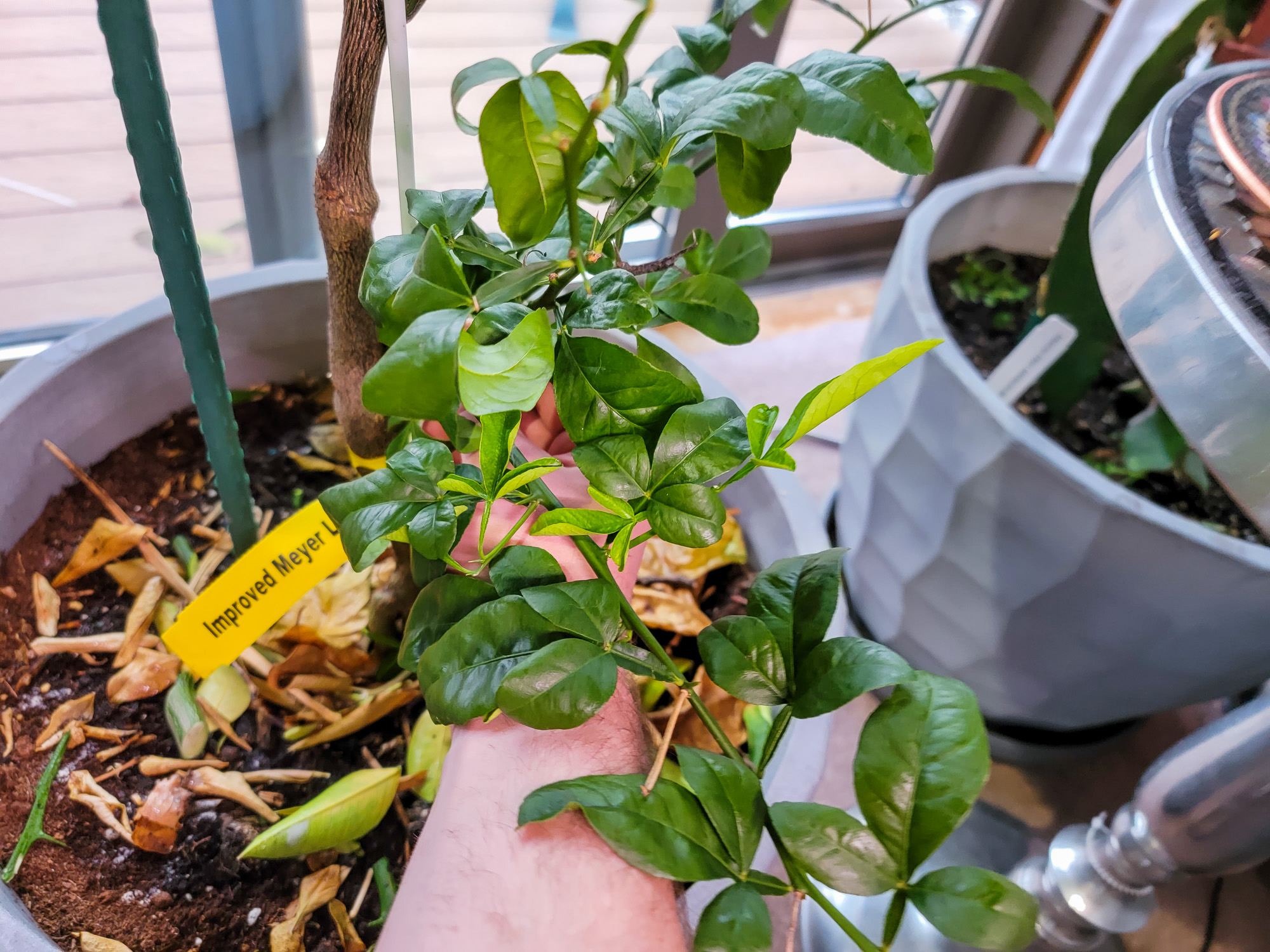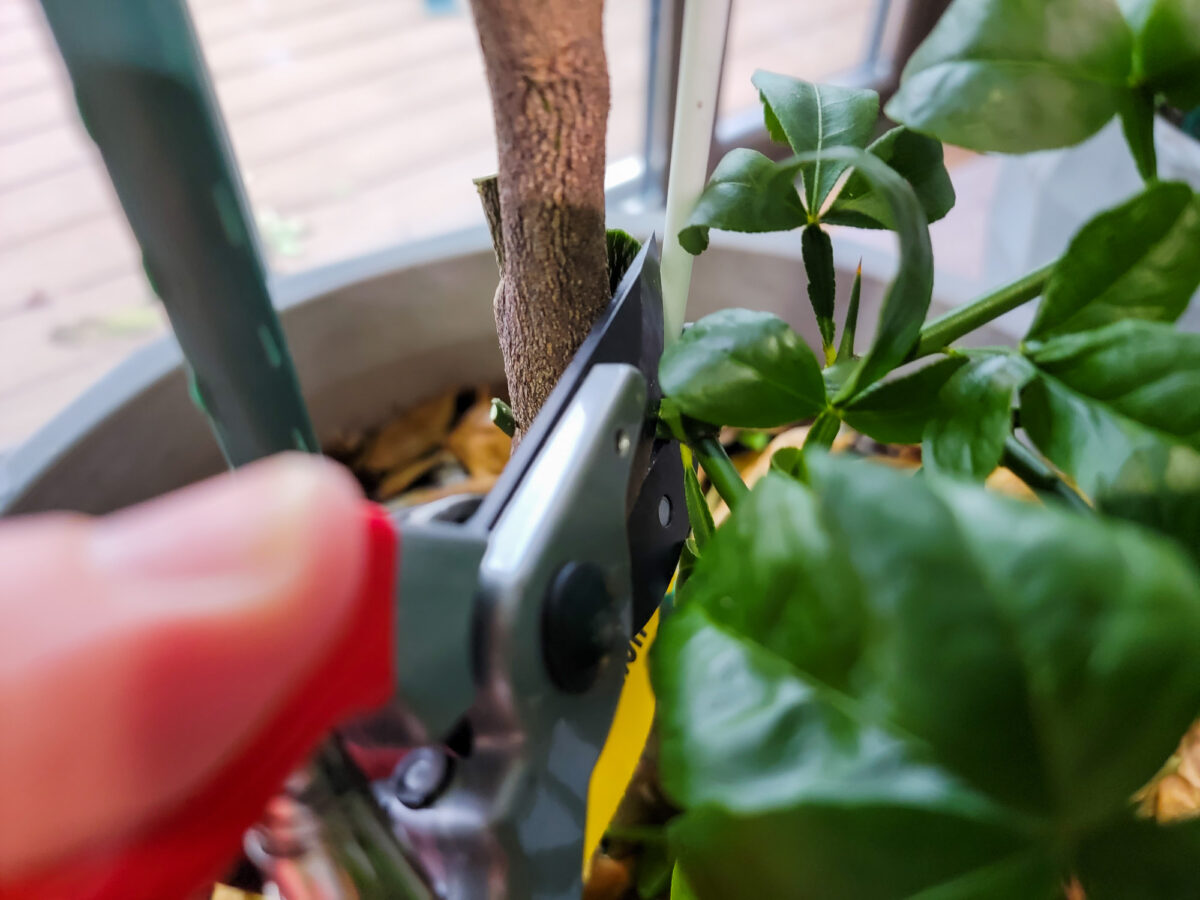Disclaimers: Our site uses demographic data, email opt-ins, display advertising, and affiliate links. Please check out our Terms and Conditions for more information.
When we bought our Meyer lemon tree, we thought it looked odd. We couldn't quite place our fingers on why, but it amounted to the fact that some leaves and branches seemed different.
One set of leaves had a single lobe, while other sets had three lobes similar to those of a very large clover.
It wasn't until the tree started producing flowers that we realized only specific branches were budding (only the branches with single-lobed leaves), and we investigated further.
As it turns out, we had a huge issue– fruit trees should not have two unique sets of leaves and the rootstock was growing a bit out of control!
What Does it Mean When a Citrus Tree Has Two Types of Leaves?
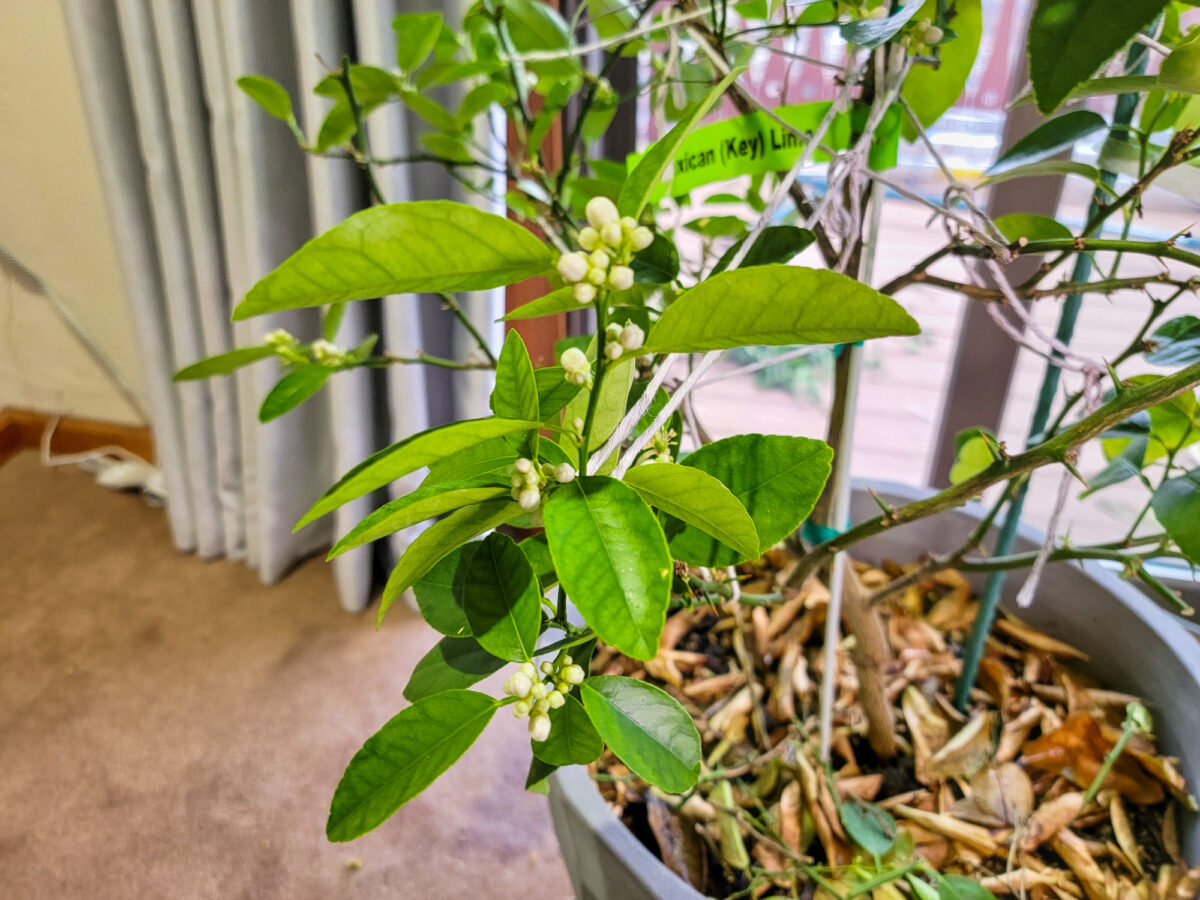
The most likely culprit when your citrus tree has two unique sets of leaves is that the rootstock was allowed to send out growth that now competes with the grafted citrus tree you purchased and intend to grow (the tree you want is often referred to as the scion or cultivar).
But why does this happen?
Many plants are not grown directly in the soil as expected but are grafted onto another compatible plant for growth.
There are many reasons this is done, and it could be for enhanced disease or pest protection, better uptake of water and nutrients in more diverse soil types, improved hardiness in colder climates, or, in the case of dwarf plants (like our own household citrus trees), to control overall vigor and growth outright.
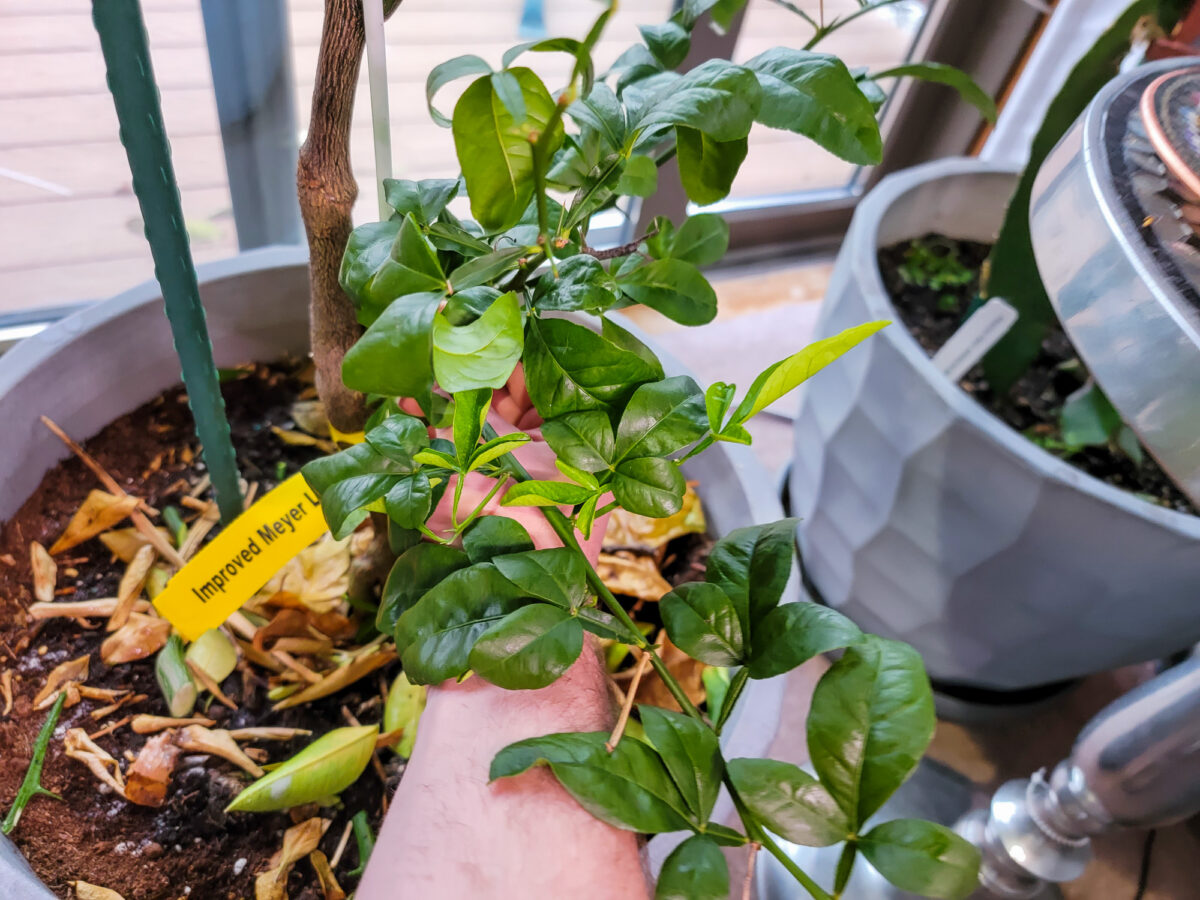
Using rootstock is not exclusive to citrus trees like ours, too. Many other plants use grafting onto rootstock to have the best chance of survival, and popular fruits like apples, pears, peaches, and even grapes may use them!
At the end of the day, however, the rootstock that your tree is grafted onto is still a plant, likely another species within a similar family (so, for citrus trees, another type of citrus tree), and they also like to grow when allowed.
As such, if your citrus tree has two kinds of leaves, odds are good that it is likely the rootstock sending out growth as well!
How to Determine if Rootstock is Growing
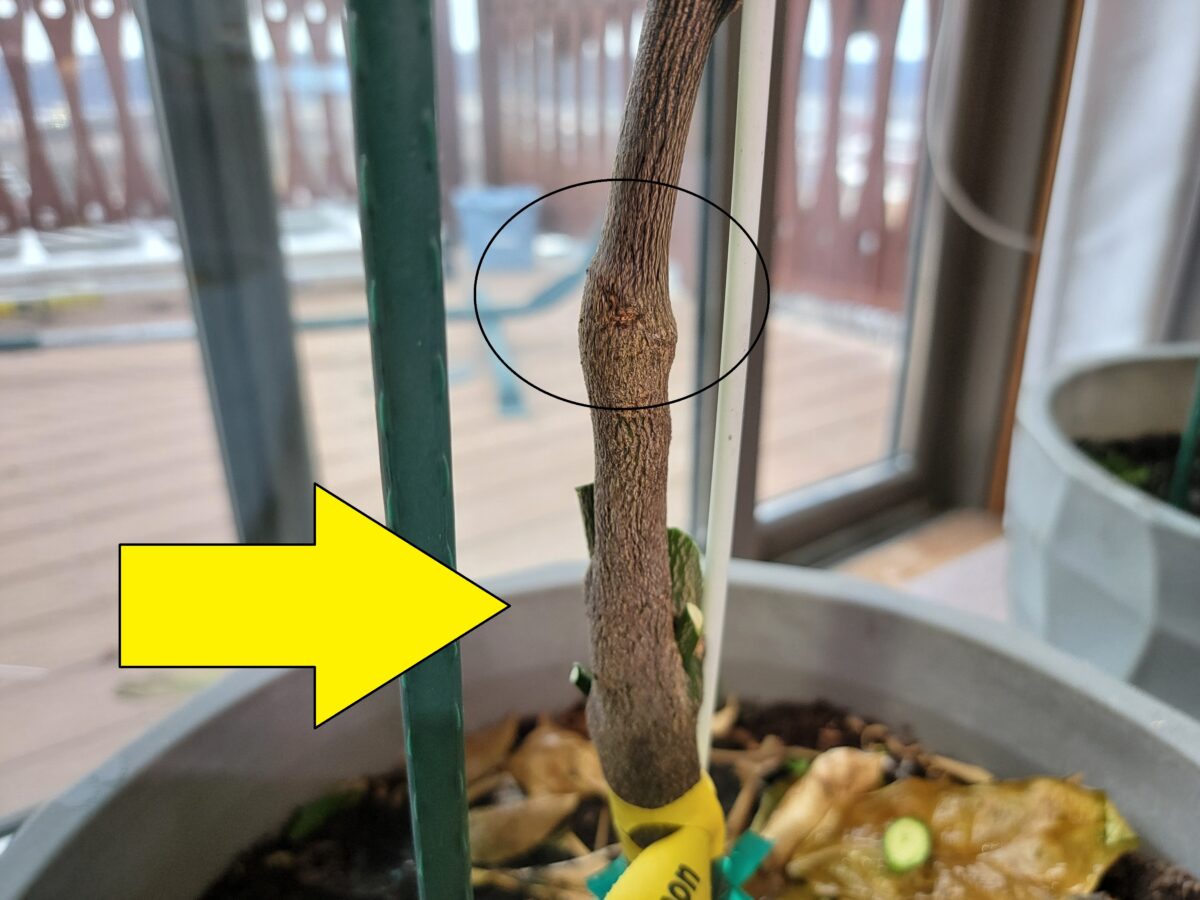
The easiest way to check to see if your citrus tree's rootstock is sending out growth is to look at the tree's base.
All you have to do here is look for the graft line, which is the point at which the citrus tree you purchased (the scion/cultivar) was added to the partnered rootstock. These lines can become less pronounced as time goes on, but virtually all trees that have been grafted should have some form of pronounced line (or even a bulbous area with a visible line), typically at an angle, showing where two trees have been joined together a few inches above the soil line.
If you find this spot, circled in the image above, look for any growth coming from below it. If you have any, then compare the branches growing above and below the graft line and see what you find.
If your tree is like ours, you'll likely find that all of the leaves growing on branches above the graft line look much like what you would expect for the species of tree you purchased (in the case of our Meyer lemon, a single lobed leaf comparable to our other citrus trees). On the flip side, you will likely see that leaves growing on branches below the graft line look different.
In the case of citrus trees, the leaves growing on branches coming out below the graft line were the tri-lobed shape illustrated above.
As it turns out, these three-leafed growths are expected with popular rootstocks for citrus trees, and since branches containing these leaves were all growing below the graft line, we had our solution- the rootstock was taking over!
- Going beyond the shape of the leaf, other signs we noticed in the rootstock growth were much larger thorns, more of a flat branch than a round one, and a thin vein running down the middle of the branch as well. All of this was vastly different from the Meyer lemon growth found elsewhere, indicating rootstock origin.
- That said, the biggest indicator of all was simply that all of this growth was coming out below the graft line.
But why is this a problem? Well, there are many reasons for this that we should quickly summarize:
- First, and most simply, the rootstock is not the same species of tree you purchased and will not produce the intended fruit. Why buy a Meyer lemon tree and let a completely different citrus tree grow when you can still enjoy the tree you wanted in the first place?
- Second, while being in the same family for any given plant type, most rootstocks do not produce fruit that consumers consider to taste good, and that is if they ever produce fruit at all. So while you could allow your rootstock to grow and potentially yield a similar fruit, you will most likely not enjoy it. This brings up the first point one more time- we want the fruit we purchased the tree for!
- Finally, rootstock growth is ultimately a competitor to the grafted tree. They may grow vigorously, steal water and nutrients, and overall inhibit the growth of the tree you wanted in the first place. Let it grow on its own, and the rootstock could kill the grafted tree outright!
In the case of our Meyer lemon tree, the rootstock growth was so bad that it effectively dominated the Meyer lemon tree, inhibited its growth, and took over as the dominant plant.
We were lucky that we realized it while the Meyer lemon branches still had a fair bit of leaves (about 20% of the total growth, ~50 total Meyer lemon leaves remaining, with the rest being from the rootstock), but if you wait long enough, and your tree could die out completely as the rootstock overtakes it!
The Solution? Trim the Rootstock Branches
Ultimately, the solution to this problem is simple. If you have found that your tree has rootstock that is taking over, grab a pair of clean garden shears and trim off any growth below the graft line as close to the main trunk as you can. Take care to only remove any growth as being identified to come from the rootstock and not growth from the grafted tree you want to keep.
If your tree still has healthy branches and leaves growing above the graft line, clearing out any growth from the rootstock (below the graft line) can help the tree begin to right itself.
Although pruning is fast, your tree's recovery will likely be slow.
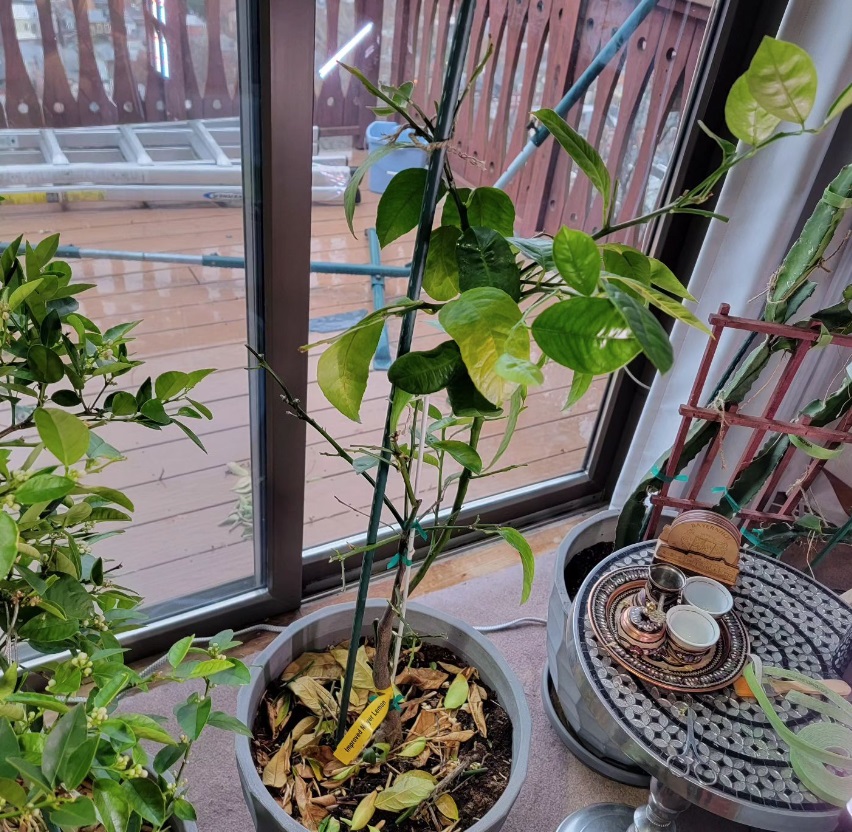
Pruning, and in cases like ours, extensive pruning, will likely be a shock to the tree. The grafted tree will see the pruning as a sign to send out new growth, which takes time (think weeks, not days). Its overall rate of recovery will be dependent on how healthy the remaining tree was to begin with.
Have a ton of healthy branches with many leaves after pruning? New growth may come in faster. Is the tree looking very sad, with few (if any) leaves remaining? It may become incredibly stressed, and recovery will take longer- if it recovers at all.
In either case, sit back, keep an eye on it, and wait- even if your tree has very few leaves at all. You never know if it will recover until you give it enough time, and the fewer leaves present likely means a longer period of recovery and a bigger risk of failure (i.e. tree death).
- Trees that have no leaves at all may even recover. However, you may want to do a scratch test on a healthy-looking branch to see if there is any living tissue (it will likely look green). This branch could still die, but as long as it is alive, there is hope. You just have to wait!
That said, it is also worth noting that pruning the rootstock below the graft line may also stimulate the rootstock to send out new growth, too. As such, keep an eye out for any growth from below the graft line and nip it out before it can grow further and start the competition again.
We want growth of our tree, not the rootstock, after all!
We are quite happy to have discovered this issue when we did, but expect that it is one that many other novice tree growers could also be experiencing. So if you think your tree is producing leaves that are unexpected, give a look at the graft line and see if your rootstock is growing when it shouldn't!
Have you recovered a fruit tree after pruning rootstock growth? How did it work out for you? Comment below to share!

